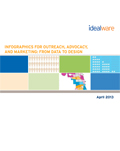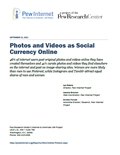Gail Evenari & Lee Friedman
See3
33 pages, 2013
This benchmark report and guide is the first to examine how and what nonprofits are doing with video and what best practices have emerged. Download the guide and find out how the nonprofit sector is using video, how to prepare and distribute wisely what metrics really matter, and what winning organizations are putting into their video effort.
Download report (PDF) after you register
Idealware
25 pages, April 2013
Idealware’s report is a guide to help you think through the process of understanding and creating infographics. In it, they cover what defines an infographic and help you create one that presents your data in a compelling and easy-to-understand way. We’ve also included a number of examples of infographics, both good and bad, to make the point clear.
Read summary
Download report (PDF) after you register
Lee Rainie, Director, Joanna Brenner, Kristen Purcell
Pew Internet Project
16 pages, September 2012
46% of Internet users post original photos and videos online they have created themselves and 41% curate photos and videos they find elsewhere on the internet and post on image-sharing sites. Women are more likely than men to use Pinterest, while Instagram and Tumblr attract equal shares of men and women.
Read summary
Download report (PDF)
Manuel Pastor, Jennifer Ito and Rachel Rosner
University of Southern California
56 pages, October 2011
This project set out to develop a framework for metrics that could serve as a bridge between interests in the community organizing field and those in philanthropy. The authors aimed to see what kinds of measures would translate the value and efficacy of organizing and provide the evidence that foundations are increasingly looking for to inform and justify investments.
Download report (PDF)
By Mayur Patel and Michele McLellan
Knight Foundation
28 pages, Oct. 18, 2011
The study offers a detailed look at some of the country’s leading online local nonprofit news ventures, providing data on how they are generating revenue, engaging users and cultivating donors. It also offers a useful way for foundations and others interested in supporting nonprofit news to think about and assess the sustainability of these types of emerging organizations.
Pew Internet Project
13 pages, March 1, 2011
Surveys by the Pew Internet Project and the Monitor Institute examined the components of local information systems that were highlighted by the Knight Commission on the Information Needs of Communities in a Democracy.
Ron Park, Merkle
5 pages, February 2011
This paper demonstrates the value proposition of Integrated Media Optimization and how budgeting and targeting by customer segment can dramatically improve the efficiency and effectiveness of the working media spend.
Read summary
Download whitepaper (PDF) after you register
Journalism.org
63 pages, March 1, 2010
(Recommended)
This report studied how people’s relationship to news has changed. The survey shows how six in 10 Americans (59%) get news from a combination of online and offline sources on a typical day, and the Internet is now the third most popular news platform, behind local television news and national television news. The report discusses two significant technological trends that have influences news consumption behavior: First, the advent of social media like social networking sites and blogs has helped the news become a social experience for consumers. Second, the ascent of mobile connectivity via smart phones has turned news gathering and news awareness into an anytime, anywhere affair for avid news watchers.
A Study of the News Ecosystem of One American City
Journalism.org
Pew Research Center’s Project for Excellence in Journalism
45 pages, Jan. 11, 2010
The study, which examined all the outlets that produced local news in Baltimore, Md., for one week, surveyed their output and then did a closer examination of six major narratives during the week, finding that much of the “news” people receive contains no original reporting. Fully eight out of 10 stories studied simply repeated or repackaged previously published information.

Patricia Aufderheide, Peter Jaszi and Mridu Chandra
Center for Social Media
26 pages, September 2009
This study provides a map of perceived ethical challenges that documentary filmmakers — directors and producer-directors — in the United States identify in the practice of their craft. It summarizes the results of 45 long-form interviews in which filmmakers were asked simply to describe recent ethical challenges that surfaced in their work.
Tony Deifell
Q Media Labs
113 pages, July 2009
Journalists and independent media makers will always be society’s most valuable truth tellers. However, the old media system that historically supported them is melting away. This report focuses on how independent media organizations can navigate the currents of change to reach higher ground over the long term.
Report page
Download report (PDF)
An Annual Report on American Journalism
Pew Research Center’s Project for Excellence in Journalism
34 pages, March 2009
The State of the News Media 2009 is the sixth edition of the annual report on the health and status of American journalism. The goals are to take stock of the revolution occurring in how Americans get information and provide a resource for citizens, journalists and researchers to make their own assessments. To do so, they gather in one place as much data as possible about all the major sectors of journalism, identify trends, mark key indicators and note areas for further inquiry.
Dale Peskin
iFOCOS Media Think Tank and Futures Lab
12 pages, February 2009
There has been grudging change as publishers covert newspapers into a digital facsimile of the printed page. The audience for online news sites has long since surpassed print circulation, reaching 69 million unique users in fall 2008, according to NAA. And the total online news audience is about 100 million—more than half total U.S. Internet users—according to ComScore. Finally there is movement. But is it too little, too late?
Download whitepaper (PDF)
Ross Dawson
Future Exploration Network
9 pages, July 2008
The traditional boundaries of the media and entertainment industry have become meaningless. Today almost every business and social activity is a form of media. An increasing proportion of our social interactions happen across media channels. Every organization is now a media entity, engaged in creating and disseminating messages among its staff, customers, and partners to achieve business objectives. This paper is intended to help yoiur organization grapple with these changes and confront the need for an effective media strategy.
Download whitepaper (PDF)
Gerd Leonhard
49 pages, July 2008
(Recommended)
A presentation, in PDF form, about the shift from disconnected media to sharing, networked, connected culture. Given at Google London.
Blog entry
Download presentation (PDF)
YouTube video of presentation
Steve Paxhia and Bill Rosenblatt
Gilbane Group
130 pages, May 2008
The study covers the market for digital editions of periodical publications and features statistics that unify audited data from two sources (BPA and ABC) with data from unaudited publications. Highlights include the number of business-to-business (B-to-B) publications offering digital editions has increased over 300 percent from 2005 to 2007; and the number of consumer publications offering digital editions has increased over 200% from 2005 to 2007. The report includes 22 case studies of publishers, representing several dozen digital edition titles, which showcase a number of industry best practices identified by the study’s authors.
Download report (PDF — registration required)
Henry Jenkins, Massachusetts Institute of Technology
Ravi Purushotma, Katherine Clinton, Margaret Weigel, Alice Robison
72 pages, October 2006
(Recommended)
A central goal of this report is to shift the focus of the conversation about the digital divide from questions of technological access to those of opportunities to participate and to develop the cultural competencies and social skills needed for full involvement.
Download report (PDF)
Shane Bowman and Chris Willis
New Directions for News/American Press Institute/iFOCOS
Edited by J.D. Lasica
Sept. 21, 2003
66 pages, July 2003
(Recommended)
What is the role of the storyteller in the new era? How will an informed, connected society and its right to know be shaped? How does the world look when news and information are part of a shared experience? This ground-breaking report explores the changes confronting news, information and media as the authors help frame a conversation about the promise and pitfalls of citizen-based, digital media in an open society.
Report page
Download report (PDF)
Beth Kanter is CEO of Zoetica, a consultancy for nonprofits. See her profile, visit her blog, contact Beth or leave a comment.























